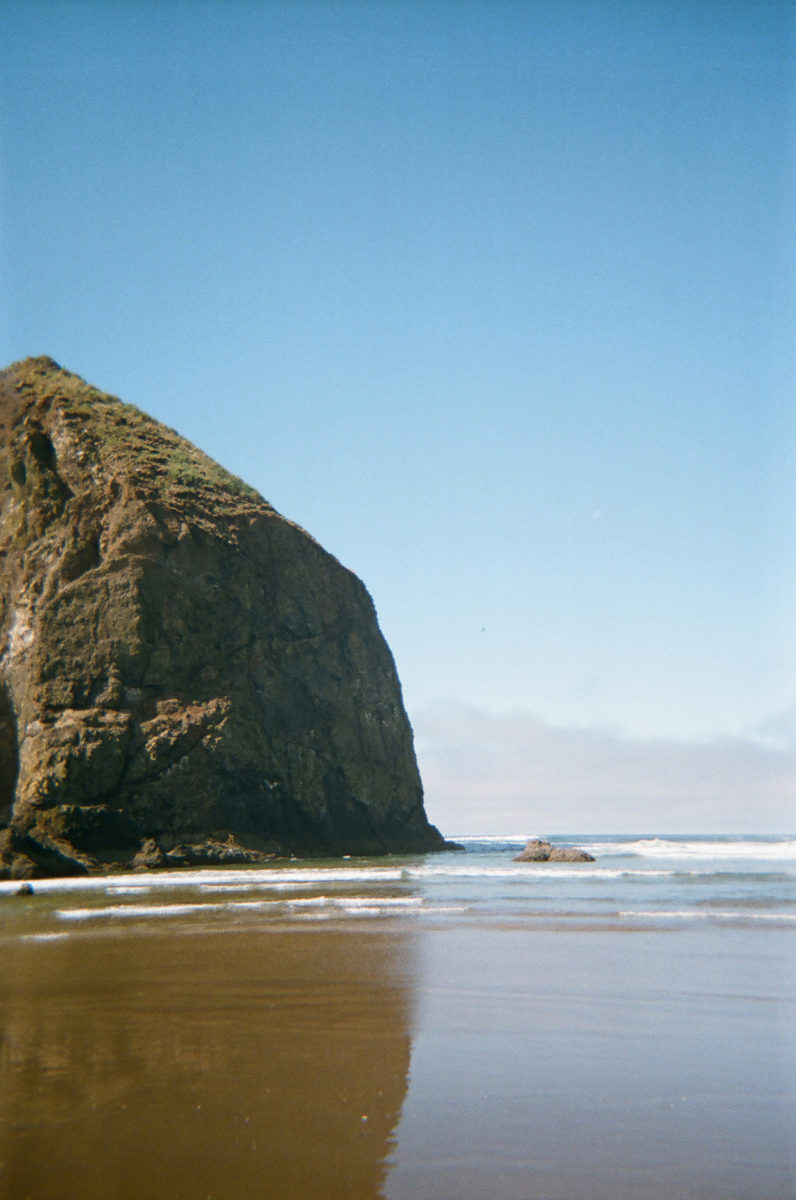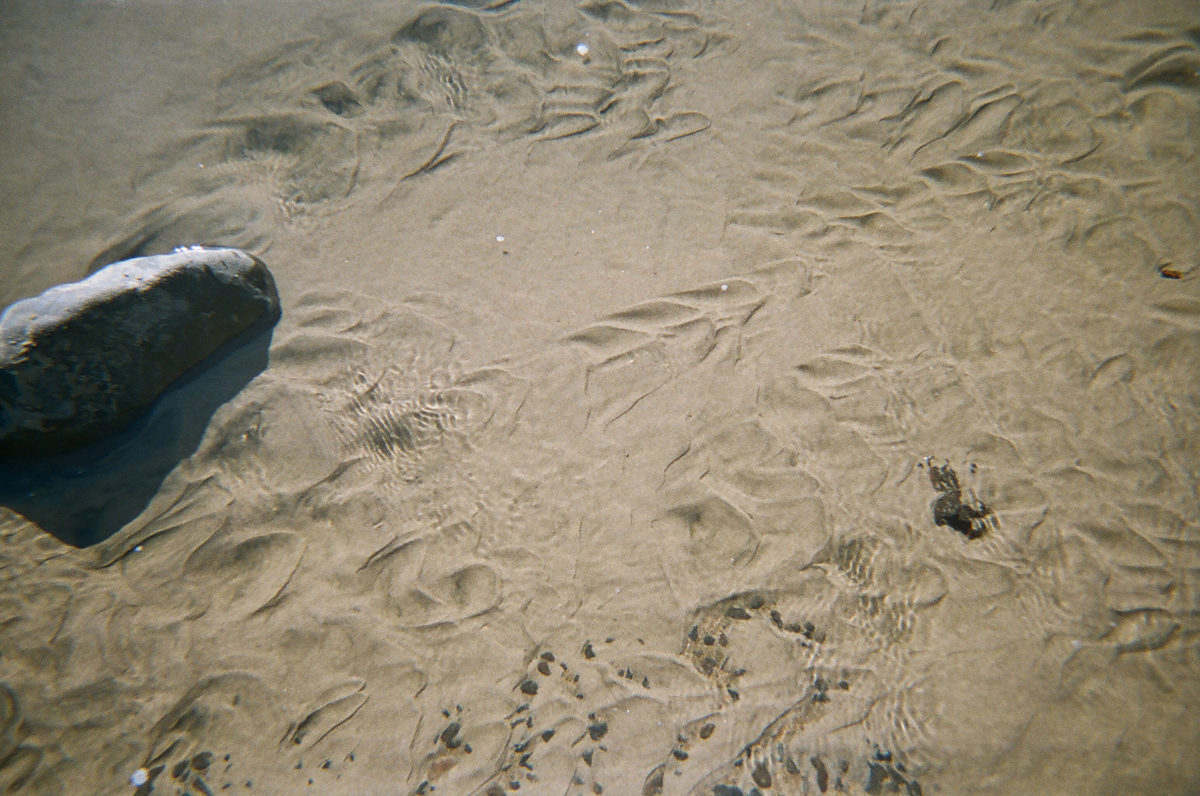At Here Magazine, we’re big proponents of JOMO—the joy of missing out—and we find that when we embrace disconnection from our daily lives through travel, the five senses really come alive. This is what our editorial designer, Chloe Scheffe, was able to see, taste, smell, hear, and touch in Cannon Beach, Oregon.
Cannon Beach sits along the northwest edge of Oregon, just south of the Columbia River, which is also the line of demarcation between Oregon and Washington, which is where I’m from.
I brought one disposable camera on my latest trip there, an annual family affair at the end of September. A disposable is the perfect medium for a beach trip because it kind of echoes the qualities of a beach—low pressure, low-fidelity, easygoing. It is how it is.
I’m not going to tell you anything you don’t already know about a beach, but this is about feelings, not knowledge, and this beach feels a very particular way.
SEE: HAYSTACK ROCK
I’ve been looking at this rock all my life. In the annals of Scheffe family photographs, there are black and white prints of my twin sister and I as babies sitting on the sand in front of Haystack, happy as clams. It’s the beacon of this beach, the mascot, and the beauty mark. If it could come to life, it would be as wise and wise-cracking as the tree in Pocahontas. It’s the domain of gulls and wayward kites (kites are a big deal here) and generations of barnacles. The tidepools at its feet are dazzling enough to put spots on your vision if you look too long. Among them there’s a little white sign, easily missed, that says not to climb the rock. Not under any circumstances.
In all these years, Haystack has never changed. Though I know it must have eroded some, the beach grass on top grown taller, the barnacles thicker or more sunbleached than when I was a child, it is a constant in my memory. (How like a rock!) If memory were like film and the negatives of my distinct trips were overlaid, Haystack would be the point of clarity, the opaque and legible feature in frame. Made so by repetition.
HEAR: WAVES
For a time my family had a house near a freeway. My parents made the best of it and told my sister and I to pretend that the sound of traffic was the sound of an ocean. We all turned cars into waves every night. It occurs to me now that Cannon Beach must’ve been the particular stretch of ocean they imagined as they fell asleep—my parents have been coming here for nearly four decades, long before we were born.
Waves are waves, yes, but these waves are especially shallow and broad, unfurling like lace or insect wings as they ascend the almost imperceptible slope of the beach. They are sudsy in some places and so clear in others that, like lens glass, they seem to magnify the image of the sand beneath them. They’re also bitterly cold. They sting the feet, then numb them—but then they soothe too, sounding like every other wave that has ever come to land, as even and constant as, well, traffic.
TOUCH: SAND
I take this trip every year, and every year we ride recumbent bikes. It’s not the trip without the bikes. Cannon Beach is ideal for cycling because the portion of the beach that’s dry is shallow, while the band of wet, rideable stuff is just enormous. (For me, the platonic ideal of beach.)
The dry sand sinks every wheel. It’s velvety and irresistible. We take our shoes off immediately, working it between our toes, dragging the bikes behind us. We pick handfuls up, then let them seep through our fingers. Dry sand sticks to everything. The soles of my shoes are fuzzy to the degree that they seem like they were made fuzzy, or matured into fuzziness, like a Chia Pet from an alternate universe.
The wet sand is soft, and has a subtler glimmer. Its slight give underfoot reminds me of memory foam. Our bike wheels leave little earthly contrails that immediately begin to fill with water and lose their form. The wet sand goes on and on. When the tide is out, people ride horses on it.
Wet or dry, sand ends up in my suitcase. I’ve got Oregon sand hiding along my Brooklyn floorboards, guaranteed.
TASTE: SALT, COFFEE
Pacific Northwest beaches are briny. They bite back. In anthropomorphic terms, they’re sort of standoffish, not like the easygoing beaches of Southern California or Florida. Here, salt is on the nose—calling to mind rough fleur de sel curls or rock salt, not fine, refined table salt—and, by association, on the tongue. It’s a fresh saltiness that speaks of circulation, and of life. When I think of losing this beach to the San Andreas fault quake, which within the next 50 years is predicted to devastate this coastline, I tear up.
My palette cleanser is an iced coffee from Sleepy Monk, a cafe just off the beach. Even in a little seaside town like this one, the coffee is excellent—the roasters here share the attentiveness and skill of those in the coffee meccas of Portland and Seattle. The decor is part log-cabin, part upscale-hippy—for some reason blown glass is always in the lineup of Pacific Northwest kitsch—but the cumulative effect is cozy.












